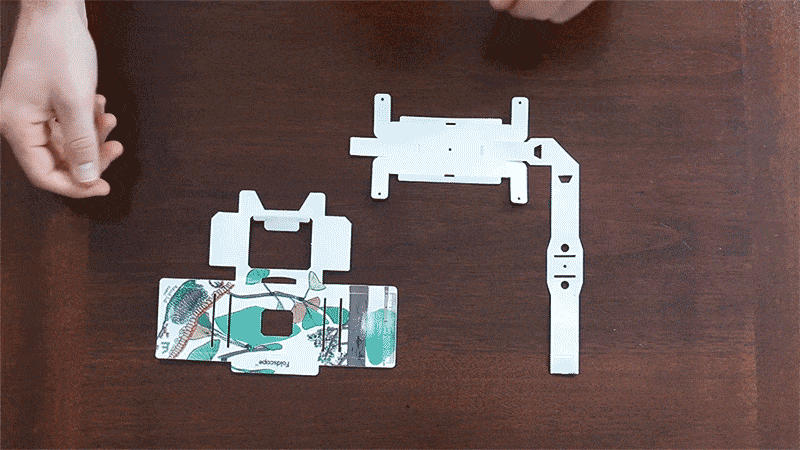Foldscope
ABSTRACT
We live on a planet where 90% of all microbial life is still yet to be described. In such a context, limitations of tools to explore the living world are some of the biggest impediment to discovery. This becomes acute when we realize that we are living in the sixth-extinction with massive biodiversity loss unfolding around the world - specially in developing nations with weaker protection laws.
Foldscope is an origami microscope - and was our answer to an act of activism in science. It is a tool - that is designed to cost less than a dollar but still provide 0.7 micron resolution and sufficient to image a single bacteria with bright field, dark field and angular-phase imaging. I conceived of this project while in the field in Thailand - at a rabies clinic where I saw a locked room with a microscope while a patient waited outside. The fact that our scientific tools don’t reach the masses is a broader challenge that led to the principle of “frugal science” that we have applied broadly on a large number of tools. On a technical front; Jim and I did the first calculations to show that fat lens equations in this context could be solved exactly with an optimal aperture - which finally led to the current resolution of the instrument.
-
General website: https://foldscope.com
Community website: https://microcosmos.foldscope.com -
BIG QUESTION
“What is the best microscope you can build for under $1 in parts?”
Foldscopes Distributed:
2+ Million
Countries:
164+
Workshops:
10,000+
External Publications:
750+
What is Foldscope?
Foldscope is the paper microscope that combines low-cost materials with precision optics. This innovation results in microscopes that are both high-quality and affordable. The technology behind the Foldscope was first published in June 2014 in PLoS ONE. That same year, Foldscope’s pilot program began with support from the Moore Foundation, Stanford University’s Spectrum Medtech, and the Coulter Foundation. The pilot program alone distributed over 70,000 Foldscopes to 135+ countries. Much of this work was carried out by volunteers and at no cost to the recipient. In exchange for the Foldscopes, we only asked that recipients contribute their findings to our budding online community, the Microcosmos.
Once the global distribution of Foldscopes began to swell, an astonishing diversity of applications were (and continue to be) revealed. For example, Foldscopes were used to identify the microscopic eggs of agricultural pests in India, to catalog the biodiversity of soil arthropods in the Amazon, detect fake currency and medicine, follow toxic blooms, detect bacteria in water samples, map pollen diversity in a city landscape, among thousands of other things.
In December 2015, Foldscope Instruments, Inc. was founded. The company was founded with the goal of scaling up production and eventually releasing other low-cost scientific tools. To date, over 2 million Foldscopes have been distributed.
How it Began
The story of foldscope is well documented - but what is less known are the first shaky steps. Even after we had demonstrated that the tool works - we could not find anyone to fund this work to scale up. Often funders thought this could not be possible or just thought we were building toys. It took us building 75,000 foldscope in the lab over a period of 3 months to convince funding partners to realize that we can scale up these efforts using robotics. Deployment of those 75,000 foldscope seeded the global community that thrives till today.
Where is Foldscope Today?
After a decade of work - over 2 million Foldscopes are in use around the world - in more than 160+ countries. We have developed education programs from Kilimanjaro to Kansas, from Connecticut to Congo and the global foldscope community inspires us to keep developing broader range of tools for scientific curiosity and exploration. This story is as much about foldscope as about a community of curious explorers that we seeded with simple beginnings. Many new species have been described in the literature - with over 500 publications written by community members on 100’s of different uses of foldscope from detecting fake drugs to diagnostics of parasites in elephant and gorilla poop. The range of applications are documented online in peer reviewed publications - but the true impact of this tool is in community members that run foldscope workshops and share the passion of science on streets across the world.






Community
Built upon the foundation of citizen science, Foldscope has garnered a community of scientists, researchers, and discoverers under Microcosmos. See what the community is up to!
Project Status
Ongoing - working toward scaling Foldscope community to 10M kids worldwide.
Project Collaborators
ICGEB, DBT India, ACEER Peru + Argentina, Institute Pasteur de Dakar, Congo, Liberia, and Cameroon, Moore foundation
Project has been supported through the Terman Fellowship, The Baxter Foundation, Coulter Foundation, Spectrum Foundation (NIH CTSA UL1 TR000093), C-Idea (National Institutes of Health grant RC4 TW008781-01), Bill and Melinda Gates Foundation, Pew Foundation, and Gordon and Betty Moore foundation for financial support. Jim Cybulski was supported by NIH Fogarty Institute Global Health Equity Scholars (GHES) Fellowship. James Clements was supported by NSF Graduate fellowship. The funders had no role in study design, data collection and analysis, decision to publish, or preparation of the manuscript.






